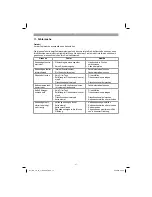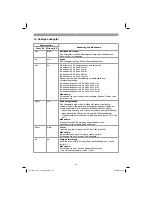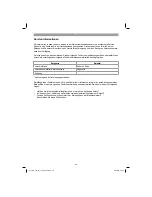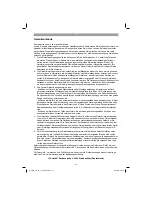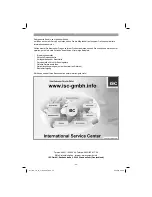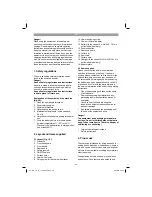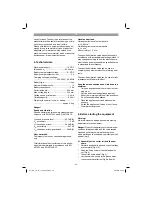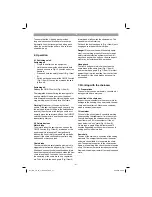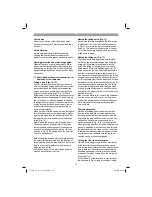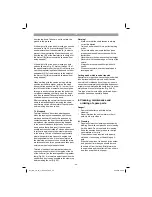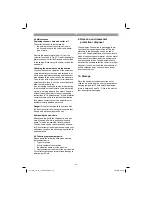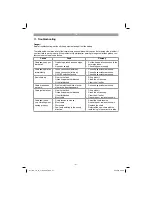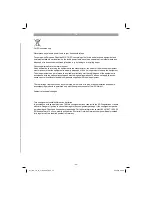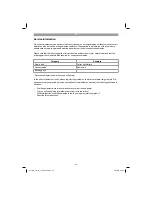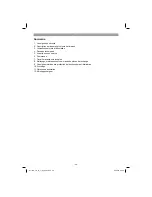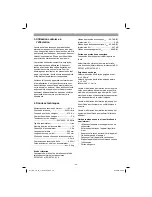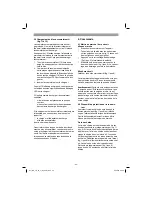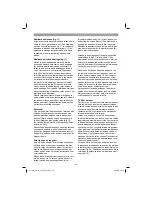
GB
- 27 -
To ensure that the Li battery pack provides
long service you should take care to recharge
it promptly. You must recharge the battery pack
when you notice that the power of the cordless
chainsaw drops.
6. Operation
6.1 Switching on/o
ff
Switching on
•
Plug in the battery on the equipment.
•
Hold the chainsaw by the handles with both
hands as shown in Fig. 13 (thumbs under the
handles).
•
Press and hold the safety lock-off (Fig. 1/Item
5).
•
Switch on the chainsaw at the ON/OFF switch
(Fig. 1/Item 6). You can then release the safe-
ty lock-off.
Switching o
ff
Release the ON/OFF switch (Fig. 1/Item 6).
The integrated brake will bring the running chain-
saw to a standstill within a very short space of
time. Always disconnect the mains plug when you
stop working, even if it is only for a short time.
Warning!
Always carry the saw by the front
handle. If the saw is plugged in and you carry it by
the rear handle (which is where the switches are
located), then there is a risk that you could acci-
dentally press the safety lock-o
ff
and the ON/OFF
switch at the same time, and the chainsaw could
inadvertently start up.
6.2 Safety devices
Motor brake
The motor brakes the saw chain as soon as the
ON/OFF switch (Fig. 1/Item 6) is released or the
power supply is interrupted. This signi
fi
cantly
reduces the risk of injury that would otherwise be
present if the chain continued to run after being
switched o
ff
or disconnected.
Chain brake
The chain brake is a safety mechanism which is
triggered via the front hand guard (Fig. 1/Item 2).
If kickback causes the chainsaw to suddenly jerk
back then the chain brake trips and stops the saw
chain in less than 0.1 seconds. You must check
the operation of the chain brake on a regular ba-
sis. To do this, fold the hand guard (Fig. 1/Item 2)
forward and brie
fl
y switch the chainsaw on. The
saw chain must not start up.
Pull back the front hand guard (Fig. 1/Item 2) until
it engages to release the chain brake.
Danger!
Never use the saw if the safety equip-
ment is not working properly. Never try to repair
safety related protection systems yourself – al-
ways have any work done by our service depart-
ment or by a similarly quali
fi
ed workshop.
Hand guard
The front hand guard (which also acts as the
chain brake at the same time) (Fig. 1/Item 2)
and the rear hand guard (Fig. 1/ Item 14) protect
against
fi
nger injuries resulting from contact with
the saw chain if the chain breaks because it is
overloaded.
7. Working with the chainsaw
7.1 Preparations
To ensure that you can work safely, check the fol-
lowing points before every use:
Condition of the chain saw
Inspect the chainsaw before the start of work for
damage to the housing, the power cable, the saw
chain and the cutter rail. Never use a chainsaw
which is obviously damaged.
Oil container
Fill level of the oil container. Even while working,
keep checking that su
ffi
cient oil is in the system.
To avoid damaging the chainsaw, never run the
saw if there is no oil in the system or if the oil
drops below the “min” mark (Fig. 10/Item B).
On average, a single
fi
lling will last around 15
minutes depending on the number of pauses in
cutting and the loads involved.
Saw chain
Tension of the saw chain, condition of the cutting
elements. The sharper the chainsaw, the easier
and more controllable it is to operate the chain-
saw. The same also applies to the chain tension.
Again, while working also check the chain tension
every 10 minutes in order to increase your safety.
New saw chains in particular often tend to expand
more.
Anl_GE_LC_18_Li_Kit_SPK7.indb 27
Anl_GE_LC_18_Li_Kit_SPK7.indb 27
04.04.16 09:28
04.04.16 09:28





